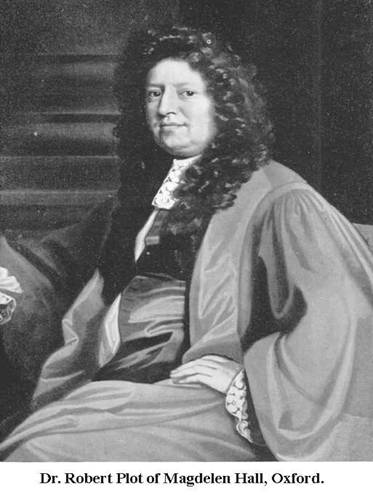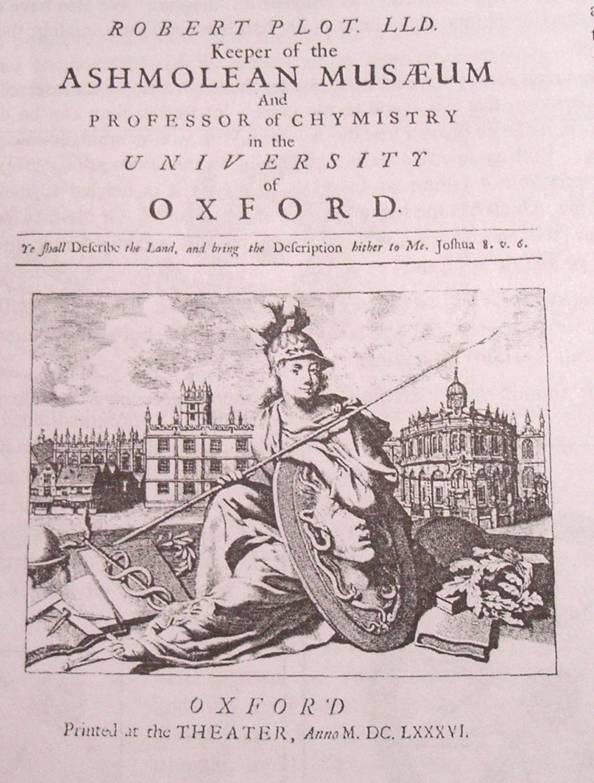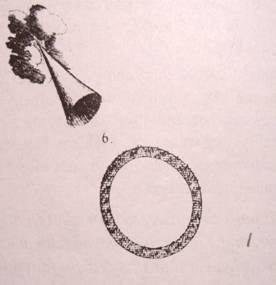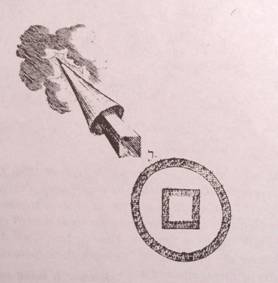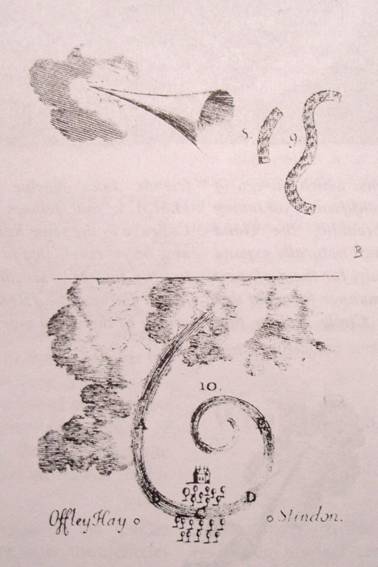|
“Fairy Circles” From the book “A natural History of Staffordshire”. Part 1. The first recorded true scientific investigation into the phenomenon of Crop Formations by Professor Robert Plot LLD. Keeper of the Ashmolean Museum and Professor of Chemistry in the University of Oxford.. Born 13th December 1640 Died 30th April 1696. He is the true, yet unacknowledged .’Father of Scientific Research’ into crop formations. It is noteworthy that Wikipedia has a brief biography covering his many activities and accomplishments but it carefully omits any reference to his important investigation of ‘Fairy Circles ‘ as described below. This work came to light in the late 1980s but it has been deliberately sidelined by skeptics and debunkers. Their reasons are obvious. This extract from his book “A Natural History of Staffordshire” published in 1686, is presented here with the original Olde English syntax and spellings where the letter ‘f’ was generally interchangeable with the letter ‘s’, the word grass is written as ‘grafs’ and singed is written ‘ finged’, cause is spelt ‘caufe’ and so on. For the our age , this’ Olde English’ can be difficult to read, though the text makes perfect sense when modernized. To facilitate ease of understanding for the casual reader, I have provided a modern interpretation of the original text, as a Part 2 addendum.to this extract.
And here perchance by the way it may be no great digreffion to enquire into the nature and efficient caufe of thofe rings we find in the grafs which they commonly call Fairy Circles: Whether they are caufed by Lightening? Or are indeed the Rendez- vouzes of Witches or are the dancing places of thofe little pygmy spirits they call Elves or Fairys?And the rather, becaufe 1.a Question (perhaps by reafon of the difficulty fcarce yet attempted, and 2. becaufe I met with a largeft of their kind ( that perchance were ever heard of ) in this county: one of them shewed me in the grounds between Handsworth Church and Heath being near Forty yards in diameter: and I was told by that ingenoius Gent. (one of the most cordial encouragers of this work) the Worshipful Sir Henry Gough Knight, that there was one in his grounds Pury- Hall but a few years fince (now indeed plowed up) of a much larger size, he believed near fifty yards, whereas there are fome of them not above two yards diameter: which perhaps may be near the the two extremes of their Magnitude. nor is their difference only in the extent of their diameters, they varying alfo in divers other repects, though not proportionably fo much: for I have always obferved that the Rims of thefe circles, from the leaft to the bigeft, are feldom narrower then a foot, or much broader than a yard: some are as bare as a path-way in many parts of them, others of a ruffet finged colour(both of thefe having a greener grafs in the middle) and a third fort of a dark green frefh, the grafs within being of a browner colour; the firft kind feldom less than five or six yards Diameter and the other two of various Magnitudes, and all thes again as well as imperfect, as perfect, some of them obtaining three parts of a circle;, others being Semicircular, some of them Quadrants, and others not above Sextants of their refpective Circles.
I thought fit to examine the nature of the Soile under the Rims of them,efpecially how it differd from the adjoining earth and found that by digging up feveral that the ground under all of them, was much loofer and dryer then ordinary/, and parts interfperfed with a white hoar or vinew much like that in mouldy bread, of a mufty rancid fmell, but to tafte insipid, and this fcarce anywhere above fix inches deep, the earth again below being of its due confiftence and genuine fmell, agreeable to the reft of the foils thereabout Whence it being equally plain that I was no longer to enquire for the origin at leaft of thefe larger circles, either from anything under of upon the ground, it remained that Ifhould look for fome higher principle, and indeed after a long a mature deliberationI could think of none nearer than the middle region: viz that they muft needs be the effects of lightning, exploded from the Clouds, moft times in a circular form; perhaps for this very reafon by the ancient Naturlifts called fulmen difcutiens: though of a vifcous fulpherous confiftenc, yet taking fire and violently breaking the cloud wherin it was pen, muft naturally expand itfelf every way obliquely, for the moft part in a uniform conical manner for as at due diftance to become a Corcle and in that form to ftrrike the Earth as may be feen fome times in arable grounds, but chiefly in wide and open pastures, whether Meadows or Uplands, where Trees and hedges interrupt leaft. And not only in a fingle but fometimes in adouble or treble Circle one within the other as was lately shewn to me by my Worthy and ingenious friend John Priauix M.A. in the field between St. Giles Church near Oxonand the garden called Jericho. They are rarely alfo seen of a quadrangular forme, encompaffed with another larger of the Circular kind. Whereof there fhewn to me no less than two examples by my ingenious and obferving friends John Natlor and Hugh Todd M.M.A.A. and fellows of the Univerfity Colledge in the fame St. Giles fields: which may be yet reconciled to the fame Hypothefis; the former proceeding from three different flafhes, the fecund widening of the orifice of the cloud more than the firft and the third more than the fecund, and fo frequently the Circles; the latter from the clouds breaking firft in a quadrangular, and often in a wider circular forme. All thefe Rings and Squares being greater or lefs in proportion to the diftance of the cloud from the Earth, and tenacioufnefs of the matter, and all appearing at firft of a ruffet colour, the grafs juft then being finged with the lightening: but the year following were of a dark and luxuriant green, the earth underneath having been highly improved with a fat fulphureous matter (received from the Lightening )ever fince it was firft stricken, although not exerting it’s fertilizing quality till fome time after. If it be objected; that Lightening caufes thefe Circles, it mift alfo be allowed that it defends vertically; which we know to be feldom or never fee. And that fecondly if their origin be afcribed to Lightening, they muft always remain of the fame magnitude, never enlarging themfelves to a greater diameter than they had at firft; which yet we cannot but acknowledge fome of them certainly doe; having not only took note of the thing myself but had it from others of unqueftionable fidelity that remarked the fame in two the Circles mentioned in this chapter. It muft be anfwered firft that although it be true, that Lightening indeed feldom defcends vertically yet that it is feldom found too that any of thefe rings are Mathematically round, ( unlefs they happen to be on Hils or bankfides. which may be obverted in the right angles to any point of the Heavens between the Zenith and the Horizon ), moft of them being rather of a parabolic figure coming fo much nearer to a round, or receding from it in proportion, as the Lightening comes forth nearer or more remote from the Zenith: whence alfo it comes to pafs that when the Lightening is exploded ( as moft frequently it is ) in an oblique line , thefe Circles are imperfect and that more Semicircles, Quadrants and Sextants amongft them, than any other, according to the aforefaid proportion as the Lightening breaks forth of a cloud more remote from the Zenith or nearer to the Horizon; thus if it proceed from a cloud not above 15 degrees above the Horizon the lower part only of the circular explofion will brufh the furface of the Earth and will make perhaps but a Sextant of a Circle: if 22 degrees and one half above it, a Quadrant; if 45, a Semicircle; if 67 and one half, three fourths of a Circle, and fo proportionably more or Lefs in the intermediate degrees.
Note: The library in the town of Leek in the county of Staffordshire has copies of Professor Plot’s book available on loan to members. Also Reprints of the book are available on Amazon. Jack Sullivan |
